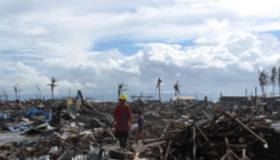Over the last two years we have collected testimonies from people who have moved as a result of climate-linked disasters. By exploring these stories we can begin to answer questions about how climate change is creating new patterns of migration and displacement. We can also begin to ask how life on a hotter planet might mean living with new kinds of disasters, and coping with the displacement they create.
The programme uses testimonies from Pakistan, the Philippines, Somalia and Mexico to examine how people have moved in response to disasters.
Programme credits:
Music: Chris Zabriskie
Cover Images: Henry Donati/Department for International Development Creative Commons (CC BY 2.0) and Russell Watkins / Department for International Development.
Testimonies:
Phillipines: Reuters Foundation
Horn of Africa: UNHCR / UNU
Mexico: EACH-FOR Environmental Change and Forced Migration Scenarios. Mexico case study report.

 |
 |
 |
 |
|---|


Very ‘moving’ stories and pictures thanks.
re. the concept of slow movement – heres an observation from Oz.
Unfortunately most Australians see these migrations and the dangers and signals they send about climate change, as very distant and not their concern (even though this country is more severely affected and threatened than much of the world).
One of the most convincing climate change ‘talks’ I have heard in a rural Aus setting was by a researcher not talking about the science, but like you, narrating stories of (generally more successful) already ‘moving with their feet’ to other regions in Australia – to seek more secure rainfall or less extreme temperatures, reduced fire risk etc.
One clear pattern is seen in [previously profitable] vineyards and wineries moving south to cooler areas – because raised temps mean their grapes ripen more quickly and varieties are all ripening at the same time – so the winery can no longer cope with volume. Only the smart and luckier ones can make these moves of course, in time to find better environments.
Of course many who see the changes still deny this ‘different weather’ as human induced climate change.